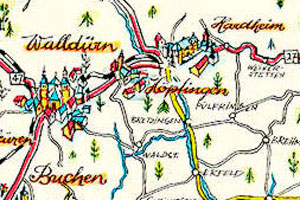 The Madonnenländchen combines the Baden part of the Odenwald, as well as some of the Bavarian part, and Bauland up to the Taubergrund. It encompasses a romantic holiday landscape where it is easy to unwind and relax.
The Madonnenländchen combines the Baden part of the Odenwald, as well as some of the Bavarian part, and Bauland up to the Taubergrund. It encompasses a romantic holiday landscape where it is easy to unwind and relax.
The name Madonnenländchen is not a geographic term but has been coined by the locals. Various Madonna statues on houses as well as a variety of shrines by the side of the road enrich the local landscape. The Madonnenländchen combines the Baden part of the Odenwald, as well as some of the Bavarian part, and Bauland up to the Taubergrund. It encompasses a romantic holiday landscape where it is easy to unwind and relax.
The name Madonnenländchen is not a geographic term but has been coined by the locals. Various Madonna statues on houses as well as a variety of shrines by the side of the road enrich the local landscape.
Almost all religions pieces of sculptural art, whether they are statues, vesper images or other representations, are being called Bildstöcke (relics/shrines) in the vernacular.
Bildstöcke do not only have an artistic and historic connotation, they also stand in vivid connection with the people. We can assume that most of the Bildstöcke have been erected in memory of a personal disaster. Others have been put up in expiation of human errors, as a sign of gratitude or even to avoid times of need.
The Madonna column in Buchen – in the vernacular called “das Bild” (the image) – is the landmark of the Madonnenländchen, it was erected after the difficult time of the Black Death. Madonnenländchen is also home to Grünkern (unripe spelt grain), a speciality of this area.
What is Grünkern?
it is also called the rice of Baden or Germany
Grünkern is made with spelt or so-called winter spelt, a special type of wheat.
The fruit is supposed to be harvested in the beginning of the milk-ripe stage while it is still green. It should then be dried in a kiln at around 120 degrees Celsius. Even thirty years ago the grain was still cut with a sickle and the green spadices have been separated from the stalks by using the pointed teeth of a reff. Nowadays modern harvesting machines have taken over this difficult task. The drying procedure in the Grünkern kiln takes about three hours. Grünkern kilns are small, barn like buildings which are mainly situated on the outskirts of Bauland due to the risk of fire. By burning dry beech wood, heating gas is set free and the green spadices are dried through thr sheet of the kiln. After the desiccation, the grains are being separated from the glumes. The farmers call this procedure tanning.
Grünkern plays an important part in today’s wholesome nutrition.
Grünkern kilns can be found in the Rinschheim district of Buchen, in the Bauland communities Altheim, Sindolsheim, and others and also in the Odenwald open-air museum in Walldürn - Gottersdorf. The most popular dishes are Grünkern soup, Grünkern casseroles, Grünkern rösties and Grünkern muesli.


